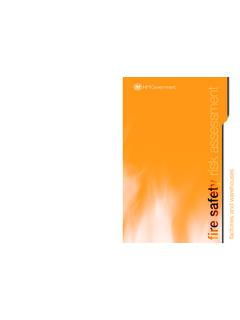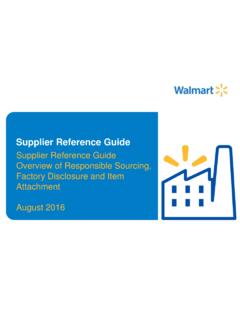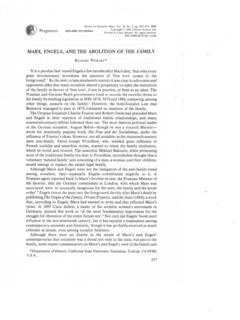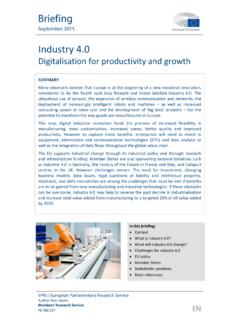Transcription of Example risk assessment for maintenance work in a factory
1 1 of 5 pagesExample risk assessment : maintenance work in a factoryHealth and Safety ExecutiveExample risk assessment for maintenance work in a factorySetting the sceneABC Engineering manufacture parts for the motor industry. The company employs 40 people on a site built in the 1970s. The managing director reviewed the company s health and safety arrangements and found that although risk assessments for the production, storage and distribution of products were done and the necessary risk control measures had been put in place, no risk assessment had been done and recorded for maintenance work in the factory .
2 The MD told the maintenance manager (the fitter ) to do this risk assessment and to put its findings into practice. Where possible, maintenance work at the factory is done in-house by the fitter. His main job is to support production by, for Example , maintaining plant, machinery and tools and undertaking minor jobs on the building fabric. The company also uses outside contractors, for Example for most building repairs, detailed repairs to machinery, and most electrical work and work on the LEV system. The fitter s job includes the selection of contractors and, with the works manager, the oversight of their work.
3 The fitter works out of a small workshop, which has some basic engineering machinery, a welding kit and secure storage for solvents and flammables. His work, however, takes him to all parts of the factory . How was the risk assessment done?The fitter followed the guidance in Five steps to risk assessment ( ).1 To identify the hazards, the fitter:looked at HSE s web pages for free health and safety advice for the engineering industry ( ) and downloaded the free publication Use of contractors: A joint responsibility ( );walked around all the areas where he and contractors may go, noting things that might pose a risk, and taking into account both HSE s guidance and those jobs that he or contractors may be required to do.
4 Talked through the issues with the safety representative, with supervisors and other members of staff to learn from their detailed knowledge of particular jobs and areas; andlooked at the accident book to get information on past The fitter then wrote down who could be harmed by the hazards and For each hazard, the fitter wrote down what was already being done to manage these, taking HSE s guidance into account. Where he did not consider existing controls good enough, he wrote down what else needed to be done to control the The fitter discussed the findings with the safety representative, with supervisors and with the managing director.
5 He gave copies of the risk assessment to them, and pinned up a copy on the notice board. Then he put the findings of the risk assessment into practice. When each action was completed he ticked if off and recorded the date. 5 The fitter decided to review and update the assessment at least once a year, or at any time when major changes to the workplace occurred, or when any out-of-the-ordinary jobs needed to be done. Important reminderThis Example risk assessment shows the kind of approach a small business might take. Use it as a guide to think through some of the hazards in your business and the steps you need to take to control the risks.
6 Please note that it is not a generic risk assessment that you can just put your company name on and adopt wholesale without any thought. This would not satisfy the law and would not be effective in protecting business is different you need to think through the hazards and controls required in your business for of 5 pagesExample risk assessment : maintenance work in a factoryHealth and Safety ExecutiveCompany name: ABC Engineering Ltd Date of risk assessment : 1/10/08 What are the hazards?Who might be harmed and how?What are you already doing?What further action is necessary?
7 Action by whom?Action by when?DoneUnfamiliarity with the site and/or uncertainty about the jobContractors may suffer injuries or ill health if they are unfamiliar with the hazards on site, such as transport and machinery or presence of asbestos, or if they are uncertain about the best way to do a job. Most of the contractors used have been to the site before (much of the work contracted out is repeat jobs , on machinery maintenance , window cleaning etc) and are familiar with layout, significant risks of the job, how to control those risks always works with company secretary and supervisor to: decide the best time for contractors to be on site.
8 And allow time for staff to know that contractors will be on site and what job they ll be jobs discussed with fitter and supervisor of the area affected, and key issues such as safe systems of work (eg isolation procedures, control of flammables etc), who will supply necessary kit (eg access equipment), and any necessary personal protective equipment, agreed before work begins. Contractors comply with company sign-in and sign-out procedures so staff know who is on site and where they manager does random checks on contractors on site to ensure, among other matters, they are working to all regular contractors to make them aware of this risk assessment and to check their awareness of health and safety issues on site.
9 Also to check that they cascade health and safety information to staff who haven t visited the site company s awareness and attitude to health and safety issues to be used as a criteria in the selection of new contractors. Fitter (in discussion with MD).30/10/0826/10/08 All new contractors to be briefed on health and safety arrangements on the now onInstruct supervisors to challenge contractors, and to inform fitter and senior managers as necessary, if they see contractors working in an unsafe and tripsFitter and contractors may suffer injuries if they slip on spillages, or trip over objects, and fall.
10 Generally good housekeeping (eg procedures for oil spillages in place and adhered to). Floors generally in good condition. Good lighting throughout. Pallets etc stored in designated area. Staff wear safety shoes with a good grip. No further action required at present. 3 of 5 pagesExample risk assessment : maintenance work in a factoryHealth and Safety ExecutiveWhat are the hazards?Who might be harmed and how?What are you already doing?What further action is necessary?Action by whom?Action by when?DoneWorkplace transportFitter and contractors may suffer very serious injuries, such as fractures and internal damage, if they are struck by a vehicle such as a lorry or a lift pedestrian/vehicle segregation measures on site, eg separate door for pedestrians to factory , marked walkways, railings were considered necessary, reversing policy for deliveries etc.
















